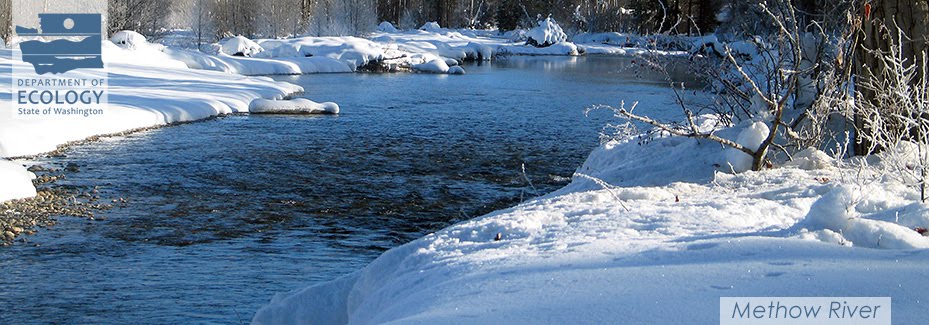 Every winter the phones at Ecology light up with questions about de-icers and anti-icers. Are they safe? Do they pollute? Is one product better than another?
Every winter the phones at Ecology light up with questions about de-icers and anti-icers. Are they safe? Do they pollute? Is one product better than another?Good questions, since nationwide we dump millions of tons of de-icing and traction materials onto our roadways every year.
"There is no black and white answer," said Mike Hepp of Ecology’s Spokane office. "National studies show there are advantages and disadvantages to each material used on the roads. Putting sand and chemicals on the roads is never a good thing for the environment, but it does keep cars out of creeks."
Managing public safety, costs, impacts
When the snow flies, we recognize that public safety is the priority. Department of Ecology stormwater regulations do not specify how local governments may use de-icers, however we encourage the use of less toxic formulas.The economics of road treatment suggest that over-application is not likely. Costs for road treatment are high for staffing and overtime, operating equipment and purchasing the materials.
Given the contrary claims of product manufacturers, differences between parts of the state, and the fact that different measures should be taken for different phases of a storm, it's difficult to say definitively what's best for the environment.
Here in the Northwest, most local and state governments responsible for keeping the roads clear look at the problem on a case-by-case basis so that the right product is used in the right place.
Product application combinations are chosen after maintenance workers evaluate factors such as air temperature, pavement temperature, humidity levels, dew point temperatures, exposure to solar radiation, type and rate of precipitation, weather forecast, weather radar data, and satellite data.
What are de-icers?
Both anti-icers and de-icers are winter road treatments that work as freezing-point depressants. Some are salt products. Some are organic compounds, and many are mixtures. However, the organic compounds are agricultural byproducts known to contain soluble organic carbon as well as nutrients such as nitrogen and phosphorus. As a result, it is possible for de-icing operations to have an adverse effect on regional waterways, by adding to nutrient and organic carbon loading.In some areas of the state, our local governments most often use magnesium chloride, a pre-snow anti-icer. The use of anti-icers means that a significantly smaller amount of chemical needs to be used, which is good for the environment.
Anti-icers, or preventive winter road treatments, are liquid forms of salt compounds used to prevent the formation of bonded snow and ice for easy removal. They are used before the onset of a winter weather storm. They work by forming a brine that has a lower freezing point than ice and snow. They keep the ice and snow from sticking to the road so it's much easier to physically remove. They also reduce the amount of sand that is used on the roadway, thus cutting down on the air pollution that arises from dry, sandy roads in the spring and summer.
A de-icer is a product that is used after it snows and after ice forms to melt the snow and ice away. De-icers, or reactive winter road treatments, are usually salt compounds used to break the bond of already existing snow and ice. They dissolve downward and penetrate until they reach the pavement. They then fan outward to undercut and separate the snow from the pavement surface.
Environmental impacts?
Both salt-based de-icers and anti-icers are easily transported with runoff water and can contaminate surface and groundwater when excessive amounts are applied. They also inhibit the growth of roadside vegetation and harm roadside habitats.So, anti-icers may have a slight environmental edge over de-icers simply because not as much is needed. One emerging alternative is calcium magnesium acetate, or CMA, made from limestone and acetic acid. It has a lower environmental impact because less is used. However, it costs more and still has a nutrient load if it reaches water.
Meanwhile, homeowners should avoid the use of fertilizers to de-ice. They're expensive, they perform poorly and you have to use quite a lot. Sand will work, but you need to sweep it up later. Don't use cat litter or ashes — they turn into goo.
This comes from the King County Stormwater Pollution Prevention Manual, "Shoveling of snow is always preferred to dumping excessive amounts of de-icing materials in an effort to avoid shoveling."
Perhaps the best thing for the environment involves getting more exercise.

1 comment:
It is nice to know this information. Even though salt is the most effective and least expensive way of de-icing, it should be used as the last resort only. This is because it is also the most damaging of all de-icing agents.
Post a Comment